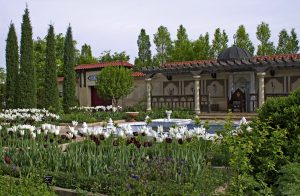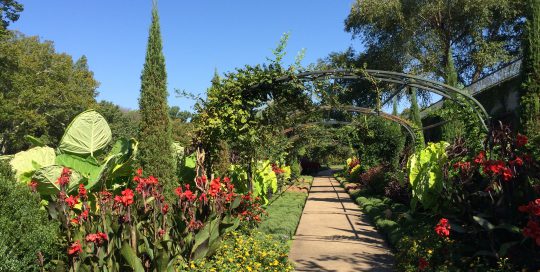The Elizabeth Morse Genius Children’s Garden provides a fun and comfortable indoor setting for families and school children. Protruding in the midst of the colorful displays is a giant seed, built to climb on. However, it is also a learning tool for looking ‘inside’ where a plant’s life begins. Children can slide down a curling stem slide, or gently stroke a sensitive plant, which closes at a touch. The garden includes extensive plantings, a pond featuring hydroponic plants, and large, sculptural displays based on the themes of plant birth, growth and reproduction.

Giant ‘Seed’: Photo by Jean Starr
Matt Barrett, Deputy Director of Conservatories, promises that this year’s spring flower show, Hashtag No Filter, will feature hanging baskets and colorful acrylic that transform the central island into an immersive and authentic natural escape. Among the many blooming plants are azaleas, tulips, Freesia, African daisy, geraniums, Ranunculus, stock, snapdragons, Marguerite daisy, weeping cherry, and flowering almond. The show takes place in the conservatory’s Show House and runs through May 13th, 2018.
So, what else is happening in early spring at the Chicago Garfield Park Conservatory? Barrett and his staff invite visitors to keep an eye out in the Aroid House for the Black Queen Anthurium, the Pink Flamingo flower and the Giant Philodendron. And in the Palm House, the climbing Oleander will be blooming. The staff has completed a new jungle path. Patrons can meander along under the canopy of large palms in order to get closer to the plants and see their features up close.
Missouri Botanical Garden (4344 Shaw Boulevard, St. Louis, MO 63110, Phone 314-577-5100)
If you could visit just three public gardens in the U.S., one should definitely be MOBOT. The acronym stands for Missouri Botanical Garden. The Garden was founded 158 years ago, and is still surprising visitors on a daily basis. At 79 acres, it’s not particularly large as public gardens go. However, its staff has done a lot with what they have.
Springtime means tulips and daffodil displays. The average peak time for spring bulb displays is early to mid-April. But in all things artistic, it’s the backdrop that makes or breaks the impact. One of the most spectacular of the spring bulb locations is the quarter-acre walled Bakewell Ottoman Garden. With its paved patio, various fountains and architectural elements fabricated in Turkey, it provides a strong sense of authenticity. And what could be more authentic than a display of tulips, which originated in that country.

Ottoman Garden: Photo by Jean Starr
Adjacent to the Ottoman Garden is the Linnean House which features sweet-scented citrus, fragrant olive trees and perfumed pink jasmine. A collection of Camellias — all at their peak from January through March — are on display at one end of the stand-alone greenhouse. Many of the plants are moved into outdoor spaces when the weather warms up.
No matter what month you visit, the geodesic-domed Climatron conservatory is a great place to be. At more than half an acre, the futuristic structure holds 14,000 species of tropical plants. These include bananas, cacao and coffee trees, plus a collection of orchids. Visit MOBOT through March 25th to see the Orchid Show, held in the Ridgeway Visitor Center.
Shoenberg Temperate House
Just north of the Climatron is the Shoenberg Temperate House, which features one of the most iconic elements at MOBOT — a beautifully-tiled Moorish walled garden that reflects major elements in the history of formal garden design. The house delivers a Mediterranean climate, warm, dry summers and cool, rainy winters. Late winter and early spring are the best times to enjoy the Temperate House, keeping in mind that spring comes two months ahead, allowing its olive, carob, bay and oak trees to leaf out ahead of time.
Unique flowers from the Mediterranean climate regions of the world include African daisies (Osteospermum fruticosum), Australian kangaroo paw (Anigozanthos flavidus) and Mediterranean throatwort (Trachelium caeruleum).
In the same house, but a world apart in cultural requirements, is a boggy display of carnivorous plants from the southeastern U.S., including pitcher plants, flytraps, butterworts and sundews.
Children’s Garden
The Doris I. Schnuck Children’s Garden is open from April through October, and offers hours of exploration for children of all ages. Features include a treehouse and a fort, which you can access through elevated bridges. A waterfall, cave, rope bridge, pollination garden, and tree slide are just a few of the highlights. A visible schedule allows parents to see all activities on offer to determine which best suit their children’s interests.
To learn more about all of the gardens within the Missouri Botanical Garden, see the most recent informational guide with garden descriptions.
Visiting public gardens is rewarding but sometimes can be expensive. Adult admission to the Atlanta Botanical Garden is $21.95. The Chicago Garfield Park Conservancy is free 365 days/year and the Missouri Botanical Garden is $12. Membership in the American Horticultural Society entitles you to special admission privileges and discounts at many public gardens. If you are an AHS member I suggest calling the garden you wish to visit to determine what is available.







